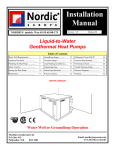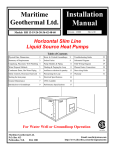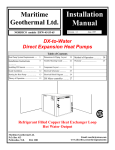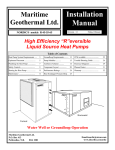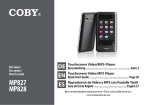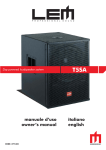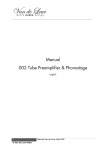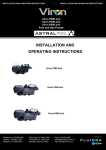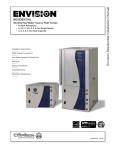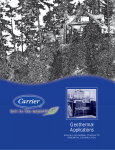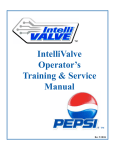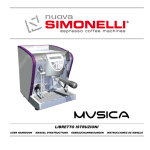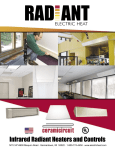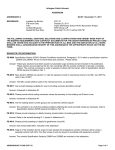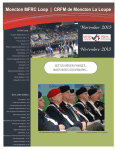Download Installation Manual
Transcript
Maritime Geothermal Ltd. NORDIC® models EMW-45-55-65 Installation Manual Revision 4.0 Liquid-to-Water EMW Heat Pumps Designed for Radiant Floor Heating Table of Contents Water Well Requirements ..... 3 Groundloop design.............. 13 Electrical Requirements ........... 22 Optimum Placement ....................... 5 Circulator pumps ……….... 15 Performance Tables.............. 23 Plumbing the Heat Pump ................ 5 Loop Flushing & antifreeze...... 17 Trouble Shooting Guide ……….. 26 Safety Controls .............................. 7 Engineering Data ................ 19 Ranco® Aquastat Controls …….. 29 Starting the Heat Pump ................... 11 General Specifications ............... 20 Electrical Diagrams ..................... 31 Maintenance .................................. 11 EMW Series features ………… 21 Warranty ................................... 35 Water Well or Groundloop Operation Maritime Geothermal Ltd. P.O. Box 413 Petitcodiac, N.B. E0A 2H0 Email: [email protected] www.discribe.ca/nordic 13-Feb-00 Maritime Geothermal Ltd. Water Well Energy Module Heat Pump System Energy Input: Solar Geothermal Groundwater Water Pump System NORDIC® Energy Module Heat Pump Fan Coils / Infloor Heat (Heat Distribution) Disposal of thermally altered water Surface Irrigation Domestic Subsurface Pond/Lake Return Well Underground Water Page .... 2 Leaching Maritime Geothermal Ltd. 13-Feb-00 NORDIC® EM Water Well System Prerequisites There are five specific parts or sub-systems to a groundwater heat pump installation: The source of energy (groundwater) Water Well The method of supplying energy to the heat pump Water Pump System Converting the energy to a useable form Heat Pump Distributing the heat Infloor Heat / Fan Coil Units Returning the exhaust water to the earth for reheating Water disposal Water Well Requirements 1. 2. 3. 4. 5. A DRILLED well of 5'' diameter or larger. Well casing properly sealed or grouted into rock. Water flow preferably entering well at a depth of 75 ft. or more. Temperature of well at least 40° F. (Normally 45+ °F.) Well must be able to supply requirements of BOTH heat pump and residence usage at the same time with maximum drawdown from static level of 30 ft. The Heat Pump A heat pump with Btu output capable of heating the home in all winter weather conditions should be selected using a “rule of thumb” as follows: Water Requirements For Nordic® Heat Pumps Model Heat Pump Home Total Nordic EMW-45 7 Igpm 3 11 Nordic EMW-55 10 Igpm 3 13 Nordic EMW-65 12 Igpm 3 15 Note: These are minimum water requirements based on an entering water temperature of 46° F. Igpm = Imperial gallons per min. Water Pump System 1. 2. 3. 4. A submersible pump is generally required. Must be able to pump the required water flow listed above at a minimum of 30 psig. at the dynamic pumping depth of your well. Make sure you select the pump using the pump manufacturers pump chart. Use a minimum of 30 gal. equivalent air bladder tank. Make sure the pump will be able to pump the required flow for the heat pump while maintaining 40 psig. on the water lines for usage in the rest of the home. Page .... 3 Model Sq. Ft of Home* Nordic EMW-45 1800 Nordic EMW-55 2700 Nordic EMW-65 3500 NOTE: Rule of thumb, use proper heat load software to determine exact requirements Maritime Geothermal Ltd. recommends that anyone considering the installation of a heat pump in their home or office have a professional heat loss / load calculation prepared on the building to determine the heating and cooling requirements. The correct sizing of the heat pump to the home can only be properly accomplished with the use of specialized software programs designed for this job. Discharge Water Methods 1. Although we highly recommend it, you do NOT necessarily have to have a return well. 2. Some of our customers do one of the following with their return or waste water: A. Run it into a drain or ditch. B. Pond, river or stream. C. Leaching field. In most instances if you run the water right out on top of the ground it will soak back into the ground in less than 50 ft. of travel. If suitable care is taken to insure that the drain pipe runs downhill and the end of the pipe is protected by a bale of hay or spruce bows etc. the end of the pipe will not freeze. When snow comes it will usually cover the entire process much like a small spring. The above information is intended to give the prospective user/purchaser some insight as to the general requirements for a successful application of the NORDIC® heat pump. 13-Feb-00 Maritime Geothermal Ltd. NORDIC® EMW Series - Open Loop Disposal Methods A. Single Well (Pump & Dump) Two Well System C Tile Bed or Leaching Field Page .... 4 Maritime Geothermal Ltd. 13-Feb-00 When setting up the unit, Maritime Geothermal Ltd. recommends the installation of a water flow meter on the discharge line so that the exact amount of water flowing can be When the heat pump reaches it's destination it should determined at a glance. Once the correct flow of water has be unpacked to determine if any damage has occurred during been established and determined to be consisshipment. Any visible damage should tent, the water flow meter could be removed be noted on the carrier's freight bill and In to Heat Pump from the line. a suitable claim filed at once. NOTE: Installing unions at each end of the Brass fitting on meter and similar unions on a piece of pipe The heat pump is well conwater lines to of the same length, allows the user to insert structed and every effort has been made heat Pump the meter in the line whenever the flow of to insure that it will arrive intact, howwater is to be checked and then remove the ever it is in the customer's best interest meter so that it does not deteriorate from day to examine the unit thoroughly when it Water (IN) to day usage arrives. and (OUT) Plumbing lines, both supply and dislines charge, must be of adequate size to handle the water flow necessary for the heat pump. 1/8” D stem ThermomeFor distances less than 40 ft. from the presThe location of liquid-to water ters & Pressure gauges sure tank, 3/4'' copper or plastic lines should heat pump inside the home should be attached through P/T port. be run while for longer distances we recomdetermined by: mend that 1'' plastic or copper lines should be 1. The ease at which piping runs run to the heat exchanger. Similarly, a 1'' line can be connected to the inshould be run from the discharge pipe to the floor heating headers on the method if disposal. output side of the unit. 2. Space availability in a mechanical room for the heat Install a P/T (Pete’s Plug) plug on the Water (IN) and pump and associated piping. Water (OUT) lines just outside the heat pump so that it is 3. Ease of access to the water well supply and discharge easy to record the water in and out temperatures and lines or groundloop lines. pressures accurately. If possible the six main service doors should remain Ideally there will be water flow available in excess clear of obstruction for a distance of (2) two ft. so that servicof the requirement of the heat pump. In such a situation the ing and general maintenance can be carried out with a miniproper pump can be selected to maintain a pressure of 30 to mum of difficulty. Raising the heat pump off the floor a few 40 psig. on the lines when the heat pump is operating. inches is generally a good practice since this will prevent unHowever in some cases a well can supply a heat pump only if necessary corrosion of the bottom panel of the unit. the We recommend that the heat pump be placed on a piece of 2'' Styrofoam covered with 1/4'' plywood. The Styrofoam will smooth out any irregularities in the cement floor while the plywood will distribute the weight of the NORDIC® unit evenly over the Styrofoam. This process will also deaden the compressor noise emitted from the bottom of the cabinet. Unpacking Placement As an alternative, several pieces of 2''x 4'' lumber can be placed under the unit running from the electrical connection side to the opposite side of the heat pump. Laying the 2''x 4'''s in this manner will give the best support since they will be at right angles with the internal steel compressor and heat exchanger support. Plumbing the Heat Pump (water well application) When installed on a water well, the NORDIC® heat pump must be supplied with an adequate water supply, since in essence, water is the fuel for the unit. It is imperative that the flow requirements listed in the engineering section be closely adhered to. Page .... 5 Fittings and accessories available for P/T plug application to heat pump. 13-Feb-00 Maritime Geothermal Ltd. NORDIC® EMW – Closed Loop Connections From Loops To Loops Pump Module Energy Module (Loop Connections Shown) Page .... 6 Maritime Geothermal Ltd. 13-Feb-00 minimum requirement for water is used. Water Disposal Methods Supply water flow to the heat pump can be controlled very accurately by the installation of a reverse action pressure valve in the supply water discharge line of the unit. If the unit is a heating / cooling unit then a dual high pressure / low pressure valve or a pair of valves must be installed. Another method of regulating the flow is by the use of a “DOLE” valve. This valve will automatically control the amount of water flowing through it by varying the diameter of a flexible rubber orifice through which the water passes. If either of such valves is needed they can be supplied and installed by your dealer. All water line valves on both the supply and discharge lines should be either BALL or GATE valves since a GLOBE valve will create too much restriction across the line possibly causing the heat pump to trip out on it's low pressure safety cutout control as a result of insufficient water flow. Exposed water lines will have a tendency to sweat when the heat pump is in operation, therefore it is recommended that both the water supply and discharge lines be insulated with suitable insulation. Hot Water Connections Connection to the hot water generator feature of the heat pump is accomplished by teeing into an electric or oil fired hot water tank with a capacity of 40 gal. minimum. A typical piping diagram is shown on page 6 in this manual. Be sure to note the position of the check valve and the direction of water flow. One should be sure the tank is filled with water and is under pressure before activating the heat pump. Slightly loosen the copper union on the hot water discharge pipe to allow air to escape from the system before the unit is started. This step will make certain that the water circulator is flooded with water when it is started. Since the pump is water lubricated, damage will occur to the pump if it is run dry for even a short period. The union on the discharge water line may have to be purged of air several times before good circulation is obtained. A hand placed several feet down the line will sense when the water is flowing. The thermostats on the domestic hot water tank should be set to 100°F. since the heat pump has an internal thermostat set at a high of 115°F. By setting the tank thermostats as described, the heat pump will try to keep the tank above the cut-in point of the electric element settings thus generating hot water from the heat pump only. During periods of high demand, the electric elements may energize to help make hot water. NOTE: If (2) shut-off valves are located on the hot water lines, be sure that the valves are open when the heat pump is operating. If both valves are closed when the heat pump is operating, water will expand in the hot water heat exchanger and could cause damage to the hot water circulator pump. Page .... 7 Water disposal methods vary from area to area however some consideration should be made to prevent the cooled discharge water from immediately coming in contact with the supply source. Generally speaking, returning water to a second well, pond lake or stream is acceptable while returning water to the same well will usually cool the water so much that the heat pump will shut off on it's low pressure / temperature safety control. A return well should be a minimum of 80 ft. from the supply well for residential applications. The water returned to the well will not be necessarily be pumped into the same aquifer, depending on underground conditions, but the return well does have to be able to supply the same quantity of water as the amount you wish to recharge into it. If the static level (level when not being pumped) of a well is high (10 to 20 ft. from the surface) it may be necessary to place a watertight well cap on the well to keep the return water from flowing out the top of the well. This cap is commonly required since a certain amount of pressure is needed to force the return water back down the well if the static level is high. Return wells are not always the answer and to some it may be more satisfactory to pump the water to a pond or away into the woods. Water recharged naturally through percolation into the soil is an alternative to a recharge well. The water discharged will generally soak into the ground within a distance of 50 to 100 ft. If care is taken to make sure the end of the pipe does not freeze then this method of disposal works well. Safety Controls The NORDIC EMW series heat pump has two built-in safety controls which are designed to protect the unit from situations which could damage it. A. LOW REFRIGERANT PRESSURE (heating mode) The low refrigerant pressure control is designed to shut the unit down if the refrigerant evaporating pressure becomes too low thus risking the danger of freezing conditions in the evaporator. There are only (4) reasons why this control would activate and they are: 1. Low water flow. (See requirements for each model) 2. Low water temperature. (Below 40 °F.) 3. Dirty or fouled heat exchanger. 4. Low refrigerant charge. B. HIGH PRESSURE CONTROL The second safety control is a high pressure safety limit which monitors compressor discharge pressure. This device will not normally trip unless the water level is low in the internal storage tank. Such a situation could occur if the tank was drained for service and not refilled or the aquastat setting was set above 120° F. If one of these controls trips it will activate a 13-Feb-00 Maritime Geothermal Ltd. NORDIC® EMW– Well Water Connections Page .... 8 Maritime Geothermal Ltd. 13-Feb-00 EMW – Hot Water tank Plumbing (Alternate) The drawing above describes how to plumb a single domestic hot water tank to an Energy Module. However this technique will only allow the hot water to reach the same temperature setting as the EM internal tank. LOCK-OUT RELAY which prevents the unit from restarting until the electrical supply to the unit is broken by opening the heat pump breaker and then closing it again. If one of these controls trips there is a serious problem with the system and it must be rectified if the unit is to maintain good service. NOTE: Under no circumstances should the heat pump lock-out relay be reset more than twice in an hour. If the heat pump is shutting off because of LOW or NO water flow on the cold side then repeated resetting of the unit could cause the heat exchanger to freeze and rupture – destroying the heat pump. Electrical Connections The NORDIC unit is supplied with an opening for 3/4'' conduit nipple on the right side of the unit. Above this is another 3/8'' hole for the thermostat wire. A wiring diagram is located Page .... 9 inside the electrical box cover for quick reference and although the connections to be made are quite simple, Maritime Geothermal Ltd. recommends that a properly qualified electrician be retained to make the connections and wire the thermostat. The NORDIC® EM unit has its own digital thermostat which controls both the heat pump first stage and the electric heat second stage. Settings are described on page 26 of this manual. Starting the Heat Pump BEFORE starting the heat pump the following areas should be rechecked to assure proper operation. 1. Check all high voltage field wiring and electrical connec- 13-Feb-00 Maritime Geothermal Ltd. 3 – 4– and 5 Loop Closed Loop Header Designs Typical reverse return 3 ton (3 loop) header shown at right. In a Reverse return header system the first line out on the supply header is the last line back on the return header. A reverse return header automatically balances the flow in each loop as long as the loops are the same length and diameter. 3 2 1 Supply Header 2 1 Return Header 3 3 loop design 4 loop design Trench Walls (2-3 ft) ¾ PE 3408 loops 1¼ x ¾ x ¾ tee 1¼ x 1¼ x ¾ tee 1¼ 90° elbow 1¼ PE 3408 5 loop design ¾ 90° elbow ¾ tee Page .... 10 Maritime Geothermal Ltd. 13-Feb-00 tions inside the control box for good connection. 2. Check all low voltage thermostat to make sure they are connected properly. 3. Turn on the main power switch. Allow the power to remain ON without starting the unit for a period of 4 hours. Refrigerant migrates to the compressor oil when the compressor is unheated. On most units a crankcase heater is standard equipment on your heat pump and it will warm the compressor, dispelling the liquid refrigerant. Compressor damage can occur if the heat pump has been brought in from a cold location and immediately started up. 13. Observe the readings on the high and low pressure gauge set. With entering water temperature of 45° to 50°F, the suction pressure (blue gauge) should be approximately 53 to 58 psig. while the head or discharge pressure (red gauge) should be in the area of 225 to 300 psig. Depending on the temperature of the water in the tank. Record this information on the warranty test card. 14. Using an electronic thermometer or other accurate thermometer, record the supply water temp. ''IN'' and the water temperature “OUT“. The outlet water temperature should be from 4° to 7° F. cooler than the inlet water temperature. 4. Turn on the water supply and check all plumbing for leaks. 15. Record the supply water flow in gpm. 5. Check the domestic hot water tank to be sure it is filled with water before energizing the circuit. On systems equipped with ball valves on the domestic hot water lines, both valves must be in the open position. Never shut off both valves when the heat pump is operational, since water expanding in the hot water generator loop may cause damage to the circulator pump housing. Slightly open the union on the hot water discharge pipes to make sure that all air is out of the system and the circulator pump is flooded with water. 16. Record the time required to heat the tank up to temperature. 6. Make sure all pumps are wired, purged of air and ready to pump water. 7. Vacuum out any dust and debris that may have collected in the unit during installation. 8. Make sure the unit is sitting level. 9. Make sure the proper time-delay fuse or breaker has been installed in the electrical box. 10. Have the following tools on hand and know how to use them. ! A refrigeration gauge set. ! An electronic or other accurate thermometer ! An amprobe. ! A water flow meter. 17. Record the voltage at the terminal blocks with a digital voltmeter. 18. At the electrical disconnect switch place the amprobe jaws around the supply wires and record the current in each. General Maintenance As with any piece of equipment there will eventually be some maintenance to be done on the heat pump. NORDIC® water and loop based heat pumps are equipped with coaxial type heat exchangers. These heat exchangers are not manually cleanable however they can be cleaned with a sulfamic acid solution commonly marketed under the trade name "Iron-Out". If you suspect that the supply water being pumped through the unit is of a poor quality or you notice a decrease in performance after several years of use it may be necessary to have the liquid heat exchanger cleaned. Maritime Geothermal recommends that a qualified serviceman be retained to carry out this procedure since the solution involved is highly corrosive. The hot side of the heat pump requires no maintenance. 11. Connect your refrigeration gauge set. 12. Turn on the main power switch. The compressor should start and water will begin to be heated in the storage tank. NOTE: If the unit is equipped with an electric TACO water valve the valve will open in 30 to 60 seconds followed by the compressor. When the TACO water valve is fully open, an internal switch activates the compressor circuit. You can observe the rise of temperature in the tank via the Ranco® aquastat digital output display. If the electric backup element breakers are energized and the water is below 95°F, the electric elements will also be ON with factory aquastat settings. Page .... 11 13-Feb-00 Maritime Geothermal Ltd. Diagram A. Design # 2 Design # 1 Diagram A. Shown above are several of the many possible horizontal loop layouts which have been successfully employed in various types of ground conditions. Design # 1 Shown is a typical reverse return header system and 2 parallel loops. On a 2 ton system each of these loops would be 500 ft. long with 4 ft. spacing between the “U” sections, 10 ft spacing between the loops and buried 6 ft. underground. Design # 2 is a single loop of 1-1/4” to 1-1/2” diameter pipe with a length of 500 ft. x the tonnage of the system and buried to a depth of 6 ft. underground. Individual runs of pipe should be kept a minimum of 10 ft. apart. Diagram B. Design # 3 Design # 4 Design # 3. Shown is a vertical borehole reverse-return header system. Vertical systems generally require 125 to 175 ft of borehole per ton of heat pump for successful heat transfer to take place with the earth. Boreholes should be spaced a minimum of 10 ft apart while if land is available, 15 ft. spacing will produce better results. Boreholes should be tremie grouted from bottom to top with bentonite or a mixture of bentonite and neat cement for proper conduction with the earth. Design # 4. Shown here is a typical series loop design using 1-1/4 to 1-1/2” pipe for the loops. Some designs incorporate a double “U” tube assembly down the well which allows for better heat transfer between the earth and the loop. NOTE Many other loop designs are in common use throughout North America. For a more comprehensive manual on earthloop design refer to our Earthloop Design Manual or contact IGSHPA (International Ground Source Heat Pump Association) and request their earth systems dealer training manual. Page .... 12 Maritime Geothermal Ltd. 13-Feb-00 EMW- Series Closed Loop Installation Information discribe.ca/nordic/fusion.htm) or request a copy of the Central Tools Butt and Socket fusion manual. Introduction Many commercial buildings select a vertical or horizontal closed loop as the earth heat exchanger either because of a lack of available groundwater or for the reduced maintenance costs which can be obtained when compared to open loop systems. Often the problems which occur in a geothermal system are associated with the wells, pumps, or the direct result of utilizing poor quality water or water which is contaminated with sand or other foreign materials. Such contamination can cause premature failure with pumps, water valves, heat exchangers and return wells. To reduce these problems to a minimum a closed secondary heat exchange system is constructed with Type 3408 Polyethylene Plastic Pipe specifically engineered for the job. Materials such as PVC and polybutylene are not recommended since their underground joining process is not as reliable as the fusion process used with type 3408 polyethylene. The earthloop heat exchanger can consist of a single long length of plastic commonly called a series style heat exchanger or more commonly is found as a number of parallel loops connected to a reverse return header system. The series system for homes or light commercial applications up to 10 tons normally is constructed with 1-1/4” to 2” diameter pipe while the parallel system uses multiple branch loops from 3/4” to 1” connected to a larger header pipe system of 11/4” to 2” diameter. The parallel system offers several advantages such as: ! Less expensive pipe. ! Easier to handle the smaller pipe. ! Lower pressure drop ! Smaller circulator pump(s) Of course on larger commercial systems it would not be unusual to find header systems with up to 6” diameter pipe for fluid flow into and out of the building. Horizontal Groundloops Horizontal groundloop systems are most commonly used where land is readily available since they are cheaper to construct than their vertical counterparts. Although many configurations are available, we have found that a parallel system with one (1) 500 ft. “U” pipe per ton placed in a 250 ft. x 4 ft. wide x 6 ft. deep trench is easy to construct and provides ample ground impact area to adequately supply a 32°F or better Entering Fluid Temperature to the heat pump even in the most severe winter months. (See opposite Diagram A.) Several companies including “Thermalworks” and the International Ground Source Heat Pump Association (igshpa) provide modeling software to size the heat pump to the home and then size the loop to the demand of the home and heat pump. Consideration is given to many factors such as type of ground, moisture content and configuration of loops desired. It is often possible to shorten loop lengths and resulting costs when using some of the newer “Slinky” designs of earthloops. A comprehensive manual dedicated entirely to the installation of groundloops is available from Maritime Geothermal Ltd. which describes in detail the techniques involved in installing a closed loop system. Vertical Groundloops Vertical groundloop systems are generally the system of choice for commercial and institutional buildings since the land area available is often limited to parking lots with some adjacent landscaped areas. Boreholes of 4 to 6 in. diameter are drilled with conventional drilling equipment usually to a depth of less than 300 ft. Horizontal Groundloop Socket Fusion Mechanical joints or metal fittings of any kind are not acceptable underground in an earth loop system due to large temperature fluctuations which may loosen and break clamps and the possibility of eventual corrosion perforation in couplings and “T’s”. Fittings and joints are socket or butt fused together into one contiguous unit using a technique developed by the gas industry. A heater tool with the appropriate faces heats both the pipe and fitting for a prescribed period of time and then the two pieces are quickly removed from the heater, inserted together and held in place until the joint cools. When properly done the resulting joint is stronger than the original pipe with no chance of leaks or breaks. For more information on butt and socket fusion techniques see our website at (http://www. Page .... 13 2 Well System Vertical Boreholes 13-Feb-00 Maritime Geothermal Ltd. Page .... 14 Maritime Geothermal Ltd. 13-Feb-00 Each “ton” of heat pump installed requires approximately 150 ft. of borehole. The 3/4” to 1” plastic pipe “U” tubes are fused together using socket fusion techniques and then pressure tested for leaks at 100 psig. using either water or air. Provision should be made to allow enough extra pipe to extend from the boreholes to the proposed location of the header system. Prior to inserting down the hole the assembly must be filled with water so that buoyancy will be at a minimum when inserting the “U” tube. Cap the ends so that mud and Grundfoss® Model UPS 26-99 or Taco® Model 0011 pump for systems up to 3 ton and (2) pumps for systems up to 5 ton. These units must be able to pump at least 2.5 to 3 USgpm. per ton of heat pump for proper operation of the system. To calculate the size of pumps required use the pressure drop tables for the diameter and type of tubing used along with all elbows, T’s etc and the pressure drop through the unit’s heat exchanger to arrive at: ( total ft of head) x (3 gpm/ton) x (No. of tons) Table 1. Antifreeze Percentages by Volume Protection down to: 10°F 15°F 20°F 25°F Methanol 25% 21% 16% 10% Propylene Glycol 38% 30% 22% 15% debris cannot enter the loops during insertion and grouting. A piece of heavy rebar or galvanized pipe is attached to the bottom 10 to 15 ft of the “U” tube with tape to add weight to the assembly and also prevent it from curling up and gouging into the side of the borehole during insertion. The entire length of the assembly should be taped every 10 ft. to create greater rigidity in the “U” tube assembly as it is installed in the borehole. The “U” tube is inserted into the borehole along with the tremie pipe and the borehole is tremie grouted from bottom to within 10 ft. of the top with a mixture of neat cement and bentonite or 100% bentonite. When using bentonite refer to the manufacturers instructions for mixing and select a product that provides a total solids content of from 25 to 30% when mixed. Horizontal trenches from 4 to 6 ft. deep are dug alongside the boreholes to the building so that a reverse return (first pipe out on the supply line is the last pipe back on the return line) header pipe arrangement can be constructed to tie all the loops together. Lay out the header system so that air cannot be easily trapped in the header using a technique approved by IGSPHA or the local governing authority. Use a shovel to break away any ground between the trench and the boreholes and dig a relief no less than 30 times the diameter of the pipe to allow the pipe to bend to the header pipe without kinking. Be very careful not to disturb the original ground under the relief so that you do not have to worry about the pipe being kinked through compaction of the earth under the pipe after the trench is backfilled. Fuse the individual smaller loops to the main header loops and extend these into the home by drilling through the concrete wall or by rising up the outside of the basement wall or slab and entering the structural part of the home or building above grade. Any piping that comes within 10 ft. of the structure should be insulated with 3/8” to 1/2” closed cell armaflex insulation to prevent freezing from occurring near any structural part of the building. Likewise, all piping inside the building must be insulated to prevent condensation and subsequent dripping onto floors or walls. Circulator Pump Module When the groundloop has been brought inside the home or building to the location of the heat pump it must be connected to the pump module which generally consists of (1) Heat Pump to Circulator Piping The heat pump must be connected to the circulator pump module with a lineset suitable for the flow required with minimum pressure drop. Common line sizes would be 3/4” rubber or plastic for heat pumps from 1 to 2.5 ton while for unit sizes 3 through 5 ton, 1” lines should be used. The installation of P/ T plugs (pressure / temperature) pronounced “Pete’s plugs” should be installed on both the entering and leaving lines at the heat pump. The P/T plug will allow the installer or homeowner to check water flow through the loop by measuring the pressure difference through the heat exchanger and comparing this pressure drop to that of the appropriate model in the engineering section. (see Pressure Drop vs. Water Flow Table) Table 2. US Gal. of fluid per 100 ft. of pipe Type of Pipe Diameter Volume (US gal.) Copper 1” 4.1 1-1/4” 6.4 1-1/2” 9.2 Rubber Hose 1” 3.9 Polyethylene 3/4” IPS SDR11 2.8 1” IPS SDR11 4.5 1-1/4” IPS SDR11 8.0 1-1/2” IPS SDR11 10.9 2” IPS SDR11 18.0 Heat Exchanger Average 1.5 Flush Cart Tank 15”D x 3 ft. high 28 Flushing & Purging the Earthloop Once the earthloop has been installed and all connections are completed to the heat pump and pumping station the entire plumbing system should be pressure tested with air to 100 psig. to make sure there are no leaks on any of the inside fittings. Soap all joints and observe that the pressure remains constant for 1 hour. Page .... 15 13-Feb-00 Maritime Geothermal Ltd. Loop Pump Module Piping Page .... 16 Maritime Geothermal Ltd. 13-Feb-00 NOTE: If you use pressure gauges permanently installed on the system as in the case of a demonstration situation etc. be careful not to exceed the maximum pressure rating of the gauges to avoid damage to their mechanism. When satisfied all connections are leak free, release the air pressure and connect a flush cart (see diagram) to the flushing access ports at the pump station. A temporary flushing system can alternately be constructed using a 45 gal. barrel and a pump with sufficient volume and head capability to circulate fluid at a veTypical locity of at least 2 ft./min. through all Flush parts of the loop. Begin pumping water Cart through the earthloop making sure that the intake of the pump stays submerged at all times by continuously adding water from a hose etc. Water flowing back on the return line should be directed below the water level in the barrel or flush tank to prevent air being mixed with the outgoing water. Once the lines have been filled and no more air bubbles are appearing in the line, adjust the flow valves to circulate water through the heat pump using the same technique as described above. When all air is removed reverse the flow of water through the lines by interchanging the flush cart lines and purge again. You will be able to visibly tell when all air is removed. Installing Antifreeze In most mid and northern areas of the US and in all of Canada it is necessary to condition the loop fluid by the addition of some type of antifreeze solution so that it will not freeze during operation in the winter months. This antifreeze is required because the loop fluid will normally reach a low entering temperature of 28°F to 32°F. and refrigerant temperatures inside the heat pump’s heat exchanger may be as low as 20°F cooler. See the antifreeze concentration chart at left for details of freeze protection afforded under different concentrations. NOTE: Add enough antifreeze to allow for a temperature 20°F lower than the expected lowest loop fluid temperature entering the heat pump. NOTE: Although many different antifreeze solutions have been employed in geothermal systems, the alcohols such as methanol or ethanol have the most desirable characteristics for earthloop application. The overall heat transfer characteristics of these fluids remain high although care must be taken when handling pure alcohols since they are extremely flammable. Once mixed in a typical 25% by volume ratio with water the solution is not flammable. In situations where alcohols are not allowed as a loop fluid due to local regulations then propylene glycol is a non-toxic alternative which can be substituted . Propylene glycol should only be used in cases where alcohols are not permitted since the heat transfer characteris- Page .... 17 tics are less desirable and it becomes more viscous at low temperatures which increases pumping watts. The volume of fluid that your loop system holds can be closely estimated by totaling the number of ft. of each size pipe in the system and referencing Table 2. the for approximate volume per 100 ft. When the volume of the loop has been calculated and the appropriate amount of antifreeze is ready for addition by referencing Table 1. , drain the equivalent amount of water from the flush cart or mixing barrel and replace it with the antifreeze. When using alcohols be sure to inject it below the water line to reduce initial volatility of the pure antifreeze. If the loop is large and the tank is small it may be necessary to refill the tank with antifreeze several times to get all the antifreeze into the loop. Pump the loop for 5 to 10 minutes longer to insure the remaining fluid has been well mixed. Initial Pressurization At this point open all valves in the flow circuit and slowly close off the supply and return flush cart valves in a manner that leaves about 20-30 psig. on the system. If an air bladder expansion tank is used the bladder should be charged to the above pressure before actual water pressure is put on the system . Systems employing a commercially available loop pump kit that do not have an expansion tank, thermometers and pressure gauges will experience a greater fluctuation of pressure in the loop between winter and summer. This fluctuation is normal since expansion and contraction of the loop fluid must be handled by the elasticity of the plastic loop. Pressurize the loop to a pressure of 45 psig. when installing a system in the fall going into the heating season. If installing in spring or summer charge to 25 psig. After operating the machine for a period of time, any residual air in the system can be bled off through valved vertical standpipes in the pump module. If pressure drops below 25 psig. add additional water / antifreeze mix with the purge pump to bring the pressure back to the original setting. 13-Feb-00 Maritime Geothermal Ltd. Page .... 18 Maritime Geothermal Ltd. 13-Feb-00 NORDIC® Series EMW-45-55-65 Engineering and Performance Data 13-Feb-00 Page .... 19 13-Feb-00 Maritime Geothermal Ltd. Revision 1.3 Color: Caissie Grey Models: EMW-45-65 Style: Vertical Maritime Geothermal Ltd. EMW Series Heat Pumps Date: Sunday, February Drawn By: G.Kaye Page .... 20 Title: Dimensions Maritime Geothermal Ltd. 13-Feb-00 Revision 3.3 Color: Caissie Grey Models: EMW-45-65 Style: Vertical Maritime Geothermal Ltd. Energy Module Heat Pumps Date: Sunday, February Drawn By: G.Kaye Title: Internal Component Layout Electrical Box Expansion Tank Domestic Circulator Taco B4-06 Floor Circulator Taco 0011 5 Filter Drier TXV Compressor Receiver Accumulator 30# Pressure Relief Valve Internal SS Tank Electric Backup 9 KW General Specifications: ! ! ! ! Satin Galvanized cabinet enclosure. 316 SS (40 Igpm) tank. Separate domestic hot water heat exchanger. Integrated floor circulator pump. ! ! ! ! ! Page .... 21 Integrated expansion tank 9 KW back-up electricheat installed. 2-stage digital thermostat Pressure relief valve. Pressure guage & drain valve standard. 13-Feb-00 Maritime Geothermal Ltd. Revision 4.0 Color: Caissie Grey Models: EMW-45-65 Style: Vertical Maritime Geothermal Ltd. Energy Module Heat Pumps Date: Sunday, February Drawn By: G. Kaye Title: Component & Piping Layout Heat Pump Electrical Service Requirements Second row lists requirements with 9KW internal back-up heat installed Model EMW-45-HW EMW-55-HW EMW-65-HW Voltage 230/1 208/3 230/1 208/3 230/1 208/3 Min. Circuit Ampacity 21 61 with Elec. back-up 15 50 28 64 20 53 34 70 23 56 Recommended Wire Size 8-3 3-3 10-3 6-3 8-3 3-3 10-3 6-3 6-3 3-3 10-3 6-3 TD Fuse or Breaker 40 70 20 60 40 100 30 60 50 100 30 60 Control Wire 18-3 thermostat wire (for all) Page .... 22 Maritime Geothermal Ltd. 13-Feb-00 Performance Specification Sheets Source EWT Igpm Lpm LWT Diff HAB Model EMW-45 Pres. Sink Drop EWT LWT Igpm Diff Btu's Out Comp. Amps Comp. Watts COP CSA COP Suct. Disch Pres. Pres. 70 14 63.3 65.1 4.9 41,51 4.5 104 111. 12 7.7 55,225 17.5 4018 4.027 3.46 72.1 295 70 12 54.2 64.0 6.0 41,01 3.82 104 111. 12 7.6 54,562 17.3 3970. 3.978 3.50 71.2 292. 70 10 45.2 7.5 53,908 17.2 3922. 3.931 3.53 70.4 289. 60 14 63.3 55.6 4.8 39,30 4.5 104 111. 12 7.3 52,290 17.3 3918 3.910 3.36 69.9 291 60 12 54.2 54.6 5.8 38,83 3.82 104 111. 12 7.2 51,663 17.1 3871. 3.863 3.40 69.1 288. 60 10 45.2 7.1 51,043 17.0 3824. 3.817 3.43 68.3 286. 55 14 63.3 50.4 4.6 37,21 4.5 104 111. 12 7.0 49,512 17.1 3820 3.798 3.27 67.8 288 55 12 54.2 49.4 5.6 36,76 3.82 104 110. 12 6.8 48,917 16.9 3774. 3.752 3.30 67.0 285. 55 10 45.2 6.6 48,330 16.7 3728. 3.707 3.33 66.2 282. 50 14 63.3 45.7 4.5 35,23 4.5 104 110. 12 6.6 46,881 16.7 3680 3.733 3.21 65.0 285 50 12 54.2 44.7 5.5 34,81 3.82 104 110. 12 6.4 46,318 16.5 3635. 3.688 3.24 64.2 281. 50 10 45.2 6.2 45,762 16.5 3592. 3.644 3.27 63.5 279. 45 14 63.3 40.9 4.4 33,36 4.5 104 110. 12 6.4 44,389 16.5 3588 3.625 3.12 63.1 281 45 12 54.2 40.0 5.3 32,96 3.82 104 110. 12 6.2 43,857 16.3 3544. 3.581 3.15 62.3 278. 45 10 45.2 6.0 43,330 16.3 3502. 3.539 3.18 61.6 276. 42 14 63.3 38.1 4.2 31,59 4.5 104 110. 12 6.2 42,030 16.3 3498 3.520 3.03 61.2 278 42 12 54.2 37.2 5.1 31,21 3.82 104 110. 12 6.0 41,526 16.2 3456. 3.478 3.06 60.4 275. 42 10 45.2 5.9 41,028 16.2 3414. 3.436 3.09 59.7 272. 40 14 63.3 35.8 4.1 29,91 4.5 104 110. 12 6.0 39,797 16.1 3411 3.419 2.94 59.3 274 40 12 54.2 34.9 5.0 29,55 3.82 104 109. 12 5.9 39,319 16.0 3369. 3.378 2.97 58.6 271. 40 10 45.2 5.7 38,848 16.0 3329. 3.337 3.00 57.9 269. 63 53 48 44 39 36 34 7.2 40,52 2.75 104 111. 12 7.0 38,36 2.75 104 111. 12 6.8 36,32 2.75 104 110. 12 6.6 34,39 2.75 104 110. 12 6.4 32,56 2.75 104 110. 12 6.2 30,83 2.75 104 109. 12 6.0 29,20 2.75 104 109. 12 Operational figures below are obtained with a 15% solution of methanol (closed loop penalty) 38 14 63.3 33.3 4.8 28,324 4.5 104 109.8 12 5.8 37,682 15.9 3286 3.360 3.06 57.6 38 38 12 10 54.2 45.2 32.3 31 5.8 27,984 3.82 7.1 27,648 2.75 104 109.6 104 109.5 12 12 5.6 5.5 37,230 36,783 15.8 15.8 3246 3207 3.320 3.280 3.10 3.14 56.9 268.7 56.2 266.2 36 36 36 14 12 10 63.3 54.2 45.2 31.4 30.4 29 4.7 26,819 4.5 5.7 26,497 3.82 6.9 26,179 2.75 104 109.7 104 109.6 104 109.4 12 12 12 5.7 5.6 5.4 36,552 36,113 35,680 15.7 15.6 15.6 3203 3165 3127 3.343 3.303 3.263 3.04 3.08 3.13 55.8 268 55.2 265.4 54.5 263.0 34 34 34 14 12 10 63.3 54.2 45.2 29.5 28.5 27 4.5 25,394 4.5 5.5 25,089 3.82 6.7 24,788 2.75 104 109.7 104 109.5 104 109.3 12 12 12 5.7 5.5 5.3 35,455 35,030 34,609 15.5 15.4 15.4 3123 3086 3049 3.326 3.286 3.247 3.03 3.07 3.11 54.2 265 53.5 262.2 52.9 259.9 32 32 32 14 12 10 63.3 54.2 45.2 27.4 26.5 25 4.4 24,044 4.5 5.3 23,756 3.82 6.5 23,471 2.75 104 109.6 104 109.4 104 109.3 12 12 12 5.6 5.4 5.3 34,391 33,979 33,571 15.3 15.2 15.2 3045 3009 2973 3.309 3.269 3.230 3.01 3.05 3.10 52.5 261 51.9 259.1 51.3 256.8 30 30 30 14 12 10 63.3 54.2 45.2 25.2 24.3 23 4.3 22,766 4.5 5.2 22,493 3.82 6.3 22,223 2.75 104 109.5 104 109.4 104 109.2 12 12 12 5.5 5.4 5.2 33,360 32,959 32,564 15.2 15.0 15.0 2969 2933 2898 3.292 3.253 3.213 3.00 3.04 3.08 51.0 258 50.3 256.0 49.7 253.7 Tested in accordance with ARI 325 & ARI 330 standards & CAN/CSA C446-M94 Page .... 23 271 13-Feb-00 Maritime Geothermal Ltd. Performance Specification Sheets Source EWT Igpm Lpm LWT Diff HAB Pres. Sink Drop EWT Model EMW-55 LWT Igpm Diff Btu's Out Comp. Amps Comp. Watts COP CSA COP Suct. Disch Pres. Pres. 70 14 63.3 64.2 5.8 49,05 4.5 104 113. 12 9.1 65,510 21.0 4821 3.981 3.42 68.0 305 70 12 54.2 62.9 7.1 48,41 3.82 104 113. 12 9.0 64,658 20.8 4758. 3.930 3.46 67.1 302 70 10 45.2 8.6 47,78 2.75 104 112. 12 8.9 63,818 20.6 4696. 3.879 3.49 66.2 300 60 14 63.3 54.7 5.7 46,35 4.5 104 112. 12 8.6 61,903 20.7 4700 3.859 3.32 66.0 301 60 12 54.2 53.5 6.9 45,75 3.82 104 112. 12 8.5 61,099 20.5 4639. 3.809 3.35 65.1 298 60 10 45.2 8.3 45,15 2.75 104 112. 12 8.4 60,304 20.3 4579. 3.759 3.39 64.3 296 55 14 63.3 49.5 5.5 43,80 4.5 104 112. 12 8.3 58,495 20.4 4583 3.740 3.22 64.0 297 55 12 54.2 48.4 6.6 43,23 3.82 104 112. 12 8.1 57,735 20.2 4523. 3.691 3.25 63.1 294 55 10 45.2 8.0 42,67 2.75 104 111. 12 7.8 56,984 20.1 4464. 3.643 3.28 62.3 292 50 14 63.3 44.9 5.3 41,39 4.5 104 111. 12 7.8 55,275 20.0 4410 3.672 3.16 61.3 293 50 12 54.2 43.8 6.4 40,85 3.82 104 111. 12 7.6 54,556 19.8 4352. 3.624 3.19 60.5 291 50 10 45.2 7.8 40,32 2.75 104 111. 12 7.4 53,847 19.8 4296. 3.577 3.22 59.7 288 45 14 63.3 40.1 5.2 39,11 4.5 104 111. 12 7.6 52,231 19.7 4300 3.559 3.06 59.4 289 45 12 54.2 39.0 6.3 38,60 3.82 104 111. 12 7.4 51,552 19.5 4244. 3.513 3.09 58.6 287 45 10 45.2 7.6 38,10 2.75 104 111. 12 7.2 50,882 19.5 4188. 3.467 3.12 57.9 284 42 14 63.3 37.3 5.0 36,95 4.5 104 111. 12 7.4 49,356 19.5 4193 3.449 2.97 57.6 286 42 12 54.2 36.2 6.1 36,47 3.82 104 111. 12 7.2 48,714 19.3 4138. 3.404 3.00 56.9 283 42 10 45.2 7.3 36,00 2.75 104 110. 12 6.9 48,081 19.3 4084. 3.360 3.03 56.1 281 40 14 63.3 35.0 4.9 34,92 4.5 104 111. 12 7.2 46,638 19.2 4088 3.343 2.87 55.9 282 40 12 54.2 34.0 5.9 34,47 3.82 104 110. 12 6.9 46,032 19.0 4034. 3.299 2.90 55.2 279 40 10 45.2 6.7 45,434 19.0 3982. 3.257 2.93 54.5 277 61 52 47 42 38 35 33 7.1 34,02 2.75 104 110. 12 Operational figures below are obtained with a 15% solution of methanol (closed loop penalty) 38 38 38 14 12 10 63.3 32.4 5.7 33,00 4.50 104 110. 12 54.2 31.2 6.9 32,57 3.82 104 110. 12 45.2 29.7 8.4 32,14 2.75 104 110. 12 6.9 44,071 19.0 3934 3.283 3.09 54.2 278 6.7 43,498 18.8 3882. 3.240 3.13 53.5 276 6.5 42,932 18.8 3832. 3.198 3.18 52.8 273 36 36 36 14 12 10 63.3 30.6 5.5 31,18 4.50 104 110. 12 54.2 29.4 6.7 30,77 3.82 104 110. 12 45.2 28.0 8.1 30,37 2.75 104 110. 12 6.8 42,749 18.7 3835 3.266 3.07 52.6 275 6.6 42,193 18.5 3785. 3.223 3.12 51.9 272 6.4 41,644 18.5 3736. 3.181 3.16 51.2 270 34 34 34 14 12 10 63.3 28.6 5.4 29,46 4.50 104 110. 12 54.2 27.5 6.5 29,08 3.82 104 110. 12 45.2 26.1 7.9 28,70 2.75 104 110. 12 6.7 41,466 18.5 3739 3.249 3.05 51.0 271 6.5 40,927 18.3 3690. 3.207 3.10 50.4 269 6.3 40,395 18.3 3642. 3.165 3.15 49.7 266 32 32 32 14 12 10 63.3 26.6 5.2 27,84 4.50 104 110. 12 54.2 25.5 6.3 27,48 3.82 104 110. 12 45.2 24.2 7.6 27,12 2.75 104 110. 12 6.6 40,222 18.2 3646 3.232 3.04 49.5 268 6.4 39,699 18.1 3598. 3.190 3.08 48.8 265 6.2 39,183 18.1 3551. 3.149 3.13 48.2 263 30 30 30 14 12 10 63.3 24.4 5.1 26,31 4.50 104 110. 12 54.2 23.4 6.1 25,97 3.82 104 110. 12 45.2 22.1 7.4 25,63 2.75 104 110. 12 6.5 39,015 18.0 3555 3.216 3.02 48.0 264 6.3 38,508 17.8 3508. 3.174 3.07 47.4 262 6.1 38,008 17.8 3463. 3.133 3.11 46.8 259 Tested in accordance with ARI 325 & ARI 330 standards & CAN/CSA C446-M94 Page .... 24 Maritime Geothermal Ltd. 13-Feb-00 Performance Specification Sheets Source EWT Igpm Lpm LWT Diff HAB Pres. Sink Drop EWT Model EMW-65 LWT Igpm Diff Btu's Out Comp. Amps Comp. Watts COP CSA COP Suct. Disch Pres. Pres. 70 14 63.3 63.1 6.9 58,00 4.5 104 114. 12 10.8 78,000 24.4 5860 3.900 3.43 67.0 315 70 12 54.2 61.6 8.4 57,24 3.82 104 114. 12 10.7 76,986 24.2 5783. 3.849 3.48 66.1 312 70 10 45.2 60 14 63.3 53.7 6.7 54,80 4.5 104 114. 12 10.2 73,706 24.1 5713 3.780 3.33 65.0 311 60 12 54.2 52.3 8.1 54,09 3.82 104 114. 12 10.1 72,747 23.9 5639. 3.731 3.38 64.1 308 60 10 45.2 55 14 63.3 48.5 6.5 51,78 4.5 104 113. 12 9.9 69,648 23.8 5571 3.663 3.22 63.0 307 55 12 54.2 47.1 7.9 51,11 3.82 104 113. 12 9.6 68,742 23.6 5498. 3.616 3.27 62.2 304 55 10 45.2 9.5 50,45 2.75 104 113. 12 9.3 67,849 23.4 5426. 3.569 3.32 61.4 301 50 14 63.3 43.9 6.3 48,93 4.5 104 113. 12 9.3 65,813 23.3 5431 3.550 3.12 60.4 303 50 12 54.2 42.6 7.6 48,30 3.82 104 113. 12 9.1 64,958 23.1 5360. 3.504 3.17 59.6 300 50 10 45.2 9.2 47,67 2.75 104 112. 12 8.8 64,113 23.1 5291. 3.459 3.22 58.8 297 45 14 63.3 39.2 6.1 46,24 4.5 104 113. 12 9.1 62,190 23.0 5296 3.441 3.03 58.5 299 45 12 54.2 37.9 7.4 45,64 3.82 104 112. 12 8.8 61,381 22.8 5226. 3.396 3.07 57.8 296 45 10 45.2 8.9 45,04 2.75 104 112. 12 8.5 60,583 22.8 5158. 3.352 3.12 57.0 294 42 14 63.3 36.4 5.9 43,69 4.5 104 112. 12 8.8 58,766 22.7 5163 3.335 2.93 56.8 295 42 12 54.2 35.1 7.2 43,13 3.82 104 112. 12 8.5 58,002 22.5 5096. 3.291 2.98 56.0 292 42 10 45.2 8.7 42,56 2.75 104 112. 12 8.3 57,248 22.5 5029. 3.249 3.02 55.3 290 40 14 63.3 34.1 5.8 41,29 4.5 104 112. 12 8.5 55,530 22.4 5034 3.232 2.84 55.1 291 40 12 54.2 32.9 7.0 40,75 3.82 104 112. 12 8.3 54,809 22.2 4968. 3.190 2.89 54.4 289 40 10 45.2 8.0 54,096 22.2 4904. 3.149 2.93 53.7 286 60 51 45 41 36 34 31 10. 56,50 2.75 104 114. 12 10.6 75,985 24.0 5708. 3.799 3.54 65.3 309 9.8 53,39 2.75 104 114. 12 10.0 71,802 23.7 5565. 3.682 3.43 63.3 305 8.4 40,22 2.75 104 112. 12 Operational figures below are obtained with a 15% solution of methanol (closed loop penalty) 38 38 38 14 12 10 63.3 31.3 6.8 39,01 4.50 104 112. 12 54.2 29.9 8.2 38,51 3.82 104 111. 12 45.2 28.2 9.9 38,01 2.75 104 111. 12 8.2 52,473 22.1 4844 7.9 51,791 21.9 4781 7.7 51,118 21.9 4719 3.17 2.98 53.4 287 3.13 3.03 52.7 285 3.09 3.07 52.1 282 36 36 36 14 12 10 63.3 29.6 6.5 36,87 4.50 104 112. 12 54.2 28.2 7.9 36,39 3.82 104 111. 12 45.2 26.5 9.6 35,91 2.75 104 111. 12 8.1 50,899 21.8 4723 7.8 50,237 21.6 4662 7.6 49,584 21.6 4601 3.16 2.97 51.8 284 3.12 3.01 51.2 281 3.08 3.06 50.5 279 34 34 34 14 12 10 63.3 27.6 6.4 34,84 4.50 104 112. 12 54.2 26.3 7.7 34,38 3.82 104 111. 12 45.2 24.7 9.3 33,94 2.75 104 111. 12 8.0 49,372 21.5 4605 7.7 48,730 21.3 4545 7.5 48,097 21.3 4486 3.14 2.95 50.3 280 3.10 3.00 49.6 277 3.06 3.04 49.0 275 32 32 32 14 12 10 63.3 25.6 6.2 32,92 4.50 104 111. 12 54.2 24.3 7.5 32,49 3.82 104 111. 12 45.2 22.8 9.0 32,07 2.75 104 111. 12 7.8 47,891 21.2 4490 7.6 47,268 21.0 4432 7.4 46,654 21.0 4374 3.13 2.94 48.8 276 3.08 2.98 48.1 274 3.04 3.03 47.5 271 30 30 30 14 12 10 63.3 23.5 6.0 31,11 4.50 104 111. 12 54.2 22.3 7.2 30,70 3.82 104 111. 12 45.2 20.8 8.7 30,30 2.75 104 111. 12 7.7 46,454 21.0 4378 7.5 45,850 20.8 4321 7.3 45,254 20.8 4265 3.11 2.92 47.3 273 3.07 2.97 46.7 270 3.03 3.01 46.1 268 Tested in accordance with ARI 325 & ARI 330 standards & CAN/CSA C446-M94 Page .... 25 13-Feb-00 Maritime Geothermal Ltd. NORDIC® EMW-Series Trouble Shooting Guide Fault Possible Cause Verification Recommended Action COMPRESSOR Compressor not operating Power Failure Electric circuit test shows no voltage on the line side of compressor contactor. Check for blown fuse at heat pump’s disconnect box or blown fuse Disconnect switch open Voltmeter shows no voltage on the line side of the compressor contactor. Determine why the disconnect switch was opened, if all is OK close the switch. Fuse blown At heat pump disconnect box, volt- Replace fuse with proper size and meter shows voltage on the line type. (Time-delay) type “D” side but not on the load side. Check total load on system. Low voltage Voltmeter shows abnormally low Call power company. voltage (Below 210 v) at heat pump disconnect switch. Burned out motor Ohmmeter shows no resistance between common and run terminals or between common and start terminals. Note: Be sure compressor overload has had a chance to reset. If comp. is hot this may take several hours. Thermal overload on compressor tripped. Ohmmeter shows reading when If windings are open or overload is placed across R and S terminals and faulty, replace compressor. infinity between C & R or C & S. Make sure the internal overload has had time to reset. Faulty compressor contactor. Voltage on line side with contactor held closed, but no voltage on one or both terminals on the load side. Points pitted or burned. Replace contactor. Seized compressor due to locked or damaged mechanism. Compressor attempts to start but trips it’s internal overload after a few seconds. Attempt to “rock” compressor free. If normal operation cannot be established, replace compressor. Faulty run capacitor. Check with ohmmeter for shorts, open etc. Replace if faulty. Page .... 26 Determine cause and replace motor. Maritime Geothermal Ltd. 13-Feb-00 Fault Possible Cause (cont) Compressor not operating Open control circuit. ! ! ! Thermostat not calling for heat. High or low pressure limit open. Lock-out relay energized. Locate open control and determine cause. Replace faulty control if necessary. Compressor “short cycles” Intermittent contact in electrical control circuit. Normal operation except too frequent starting and stopping. Check for loose wiring. Check differential setting on aquastat. Widen setting to allow longer run cycles. Compressor overloaded. Check for continuity through internal overload in compressor. Observe suction & discharge pressures – make sure amp draw is within range. HEATING MODE Recommended Action Low or no evaporator Manually open water valve (if equipped) Check well pump or circ. pump for proper water flow. and measure water flow with a flowmeter. operation. Check water valve for proper operation. Unit trips off on “LOW” suction pressure control. Evaporator water supply too cold. Unit trips off on “HIGH” pres. control. Verification Measure temperature of water. Check flow rate with spec. sheet to determine if proper gpm is available. Increase flow to proper gpm for temperature of water used. Faulty low pressure ctrl. Refrigerant pressure control should open on drop at approx. 45 psig. for well operation and 35 psig. For closed loop application. The low control should reset automatically when refrigerant pressure reaches 65 to 70 psig. Heat pump can then be restarted by resetting the lock-out relay. (Turn power off then back on) Replace faulty control if it will not reset. Low refrigerant charge. Check water temp. and flow. Clean heat exchanger. If suction is still low check suction gas pres. Normal suction is 50-60 psig. (55 typical) on R-22 or R-407C on a well. Pressure should be 40-45 on a loop during heavy use. Add refrigerant slowly until sight glass clears. Install fluorescent dye and check for possible leaks with ultra violet light, halide sniffer etc.. Low or no water in tank. Aquastat set too high. TXV stuck closed Filter drier plugged. Make sure tank is full of water. Aquastat should be below 120°F. Check for refrigerant flow through TXV and filter. Open purge valve on top of tank to make sure it is full of water. Observe and adjust aquastat setting. Replace filter or TXV if required. Page .... 27 13-Feb-00 Maritime Geothermal Ltd. Fault Possible Cause COOLING MODE (OPTIONAL) Low “temperature sensor” opens. Low or no water level in evaporator tank. (Note: The function of the two heat exchangers are reversed when in cooling mode. Evap. Becomes cond. / cond. Becomes evaporator.) Verification Recommended Action Check fluid flow, strainers, pumps and valves in the system. Temp. ctrl. will open in about 1 minute if water level is low or if unit is run with suction pressure below 50 psig. Restore proper level in cold buffer tank. Purge air through relief valve. Reset lock-out relay. Replace low suction temp. thermostat. Aquastat on cold buffer tank Verify accuracy of aquastat with reli- Replace or readjust aquastat for set too low. Should be 43 – 45° able hand held thermometer. proper operation. F High Pressure limit opens. Low water flow on condenser Check flow of well water or loop wa- Restore flow and reset lock-out ter. relay. side Check for air or strainer restrictions. Water valves open. TXV possibly not opening. Liquid line possibly plugged. DOMESTIC HOT WATER PREHEAT TANK Insufficient hot water. Warm bulb with hand and observe suction pressure while operating. Circulator pump not operating. Use an amprobe to measure current draw. Blockage or restriction in the water line or hot water heat exchanger. Replace TXV or filter-drier id non operational or plugged. Replace if faulty. Check water flow and power to Remove obstruction in water pump. Check water lines for obstruc- lines. Acid treat the domestic hot tion water coil. Service Tools Dole flow control Valve Refrigeration Gauges Amprobe Digital Thermometer In-line Flowmeter Page .... 28 The Dole® flow control is a simple, selfcleaning device designed to deliver a constant volume of water from any outlet whether the pressure is 15 psig or as high as 125 psi. The controlling mechanism consists of a flexible orifice that varies it’s area inversely with pressure so that a constant flow is maintained. Maritime Geothermal Ltd. 13-Feb-00 Ranco® ETC Thermostat Controls The Ranco® ETC is a microprocessor-based electronic temperature control designed to handle the OFF/ON functions of the NORDIC® EMW unit. The ETC is equipped with an LCD display which provides a constant readout of the sensed temperature and a touch keypad that allows the user to easily and accurately select the setpoint temperatures and differentials for the first and second stages of operation. ther C1 for cooling or H1 for heating. Then press the UP or DOWN key to toggle between the C1 or H1 designation. STAGE 2 Step 5– Press the SET key again to access the stage 2 setpoint. The LCD will display the current setpoint and the S2 annunciator will be blinking on and off to indicate the control is in the setpoint mode. Then press either the UP key to increase or the DOWN key to decrease the setpoint to the desired temperature. Programming Steps and Display STAGE 1 Step 1– To start programming, press the SET key once to access the Fahrenheit/Celsius mode. The display will show the current status, either F for degrees Fahrenheit or C for degrees Celsius. Then press either the UP arrow or DOWN arrow key to toggle between the F° or C° designation. For closer regulation of your water temperatures we recommend you program in the Fahrenheit mode. Step 2– Press the SET key again to access the stage1 setpoint. The LCD will display the current setpoint and the S1 annunciator will be blinking on and off to indicate that the control is in the setpoint mode. Then press either the UP arrow key to increase or the DOWN arrow key to decrease the setpoint to the desired temperature. Step 6– Press the SET key again to access the stage2 differential . The LCD will display the current differential and the DIF 2 annunciator will be blinking on and off to indicate that the control is in the differential mode. Then press either the UP arrow key to increase or the DOWN arrow key to decrease the differential to the desired setting. ETC Location EMW Electrical Box Step 3– Press the SET key again to access the stage1 differential. The LCD will display the current differential and the Dif 1 annunciator will be blinking on and off to indicate that the control is in the differential mode. Then press either the UP arrow key to increase or the DOWN arrow key to decrease the differential to the desired setting. Step 4– Press the SET key again to access the stage1 cooling or heating mode. The LCD will display the current mode, eiPage .... 29 Step 7– Press the SET key again to access the stage 2 cooling or heating mode. The LCD will display the current mode, either C2 for cooling or H2 for heating. Then press either the up or down key to toggle between the C2 and H2 designation. Press the SET key once more and programming is complete. NOTE: The ETC will automatically end programming if no keys are depressed for a period of 30 seconds. Any settings that have been input to the control will be accepted at that point. All control settings are retained in non-volatile memory if power to ETC is interrupted for any reason. Re-programming is not necessary after power outages or disconnects unless different control settings are required. 13-Feb-00 Maritime Geothermal Ltd. Ranco® ETC Thermostats 8 ft. extension cable Cover screws (4) Temperature sensor Circuit board Mounting Holes Locking switch NOTE: The temperature “sensor” can be extended up to 400 ft. by cutting the sensor extension cable and splicing 22 gauge (2 conductor) copper wire in place. Regular telephone wire can be used for this operation. Shown Below Conduit Opening 24v Power Connection Stage 1 relay Stage 2 relay Stage 1 NC NO C Stage 2 NC C NO Page .... 30 Maritime Geothermal Ltd. 13-Feb-00 NORDIC® EMW-45-55-65-HW Series - Schematic 230/1/60 Schematic Diagram Page .... 31 13-Feb-00 Maritime Geothermal Ltd. NORDIC® EMW-HW Series Electrical Box 230v/1/60 Box – Heating & Domestic Hot Water Versions Page .... 32 Maritime Geothermal Ltd. 13-Feb-00 NORDIC® EMW-45-55-65-HW Series - Schematic 208v/3ph/60Hz Greyed Circled Items (Optional) Page .... 33 13-Feb-00 Maritime Geothermal Ltd. NORDIC® EMW-HW Series Electrical Box 208v/3/60 Box – Heating & Domestic Hot Water Versions NOTE (A) Electric Heat Back-up is An option which can be activated or deactivated by the customer by disconnecting the breaker as required. To disconnect permanently – remove wires D, E & F at left. Electric Heat Breaker & Relay A E F D Page .... 34 Maritime Geothermal Ltd. 13-Feb-00 LIMITED WARRANTY MARITIME GEOTHERMAL LTD. warrants that the heat pumps manufactured by it shall be free from defects in materials and workmanship for a period of (1) ONE YEAR after the date of installation or for a period of (1) ONE YEAR AND (60) SIXTY DAYS after the date of shipment, whichever occurs first. In addition MARITIME GEOTHERMAL LTD. warrants that the compressor shall be free of defects in materials and workmanship for an additional period of (48) FORTYEIGHT MONTHS from said date. MARITIME GEOTHERMAL LTD. shall, at it's option repair or replace any part or parts covered by this warranty which shall be returned to MARITIME GEOTHERMAL LTD., transportation charges prepaid, which, upon examination proves to be defective in materials or workmanship. Replacement or repaired parts and components are warranted only for the remaining portion of the original warranty period. This warranty is subject to the following conditions: 1. The NORDIC® heat pump must be properly installed and maintained in accordance with MARITIME Geothermal LTD.'s installation and maintenance instruct ions. 2. The installer must complete the “Installation Data Sheet”, have it endorsed by the owner and return it to Maritime Geothermal Ltd. within 21 days after the installation of the unit. 3. It is the responsibility of the building or general contractor to supply temporary heat to the structure prior to occupancy. These heat pumps are designed to provide heat only to the completely finished and insulated structure. Start-up of the unit shall not be scheduled prior to completion of construction and final duct installation for validation of this warranty. If the heat pump, manufactured by MARITIME GEOTHERMAL LTD. fails to conform to this warranty, MARITIME GEOTHERMAL LTD. 's sole and exclusive liability shall be, at it's option, to repair or replace any part or component which is returned by the customer during the applicable warranty period set forth above, provided that (1) MARITIME Geothermal LTD. is promptly notified in writing upon discovery by the customer that such part or component fails to conform to this warranty. (2) The customer returns such part or component to MARITIME GEOTHERMAL LTD., transportation charges prepaid, within (30) thirty days of failure, and (3) MARITIME GEOTHERMAL LTD. 's examination of such component shall disclose to it's satisfaction that such part or component fails to meet this warranty and the alleged defects were not caused by accident, misuse, neglect, alteration, improper installation, repair or improper testing. Page .... 35 Maritime Geothermal Ltd. has the solution for all your heating and cooling projects Vertical Liquid-to-Air Liquid-to-Liquid NORDIC NORDIC Horizontal Slim Liquid-to-Air Split Systems NORDIC® — Environmentally sound solutions to today’s Heating and Cooling needs.




































